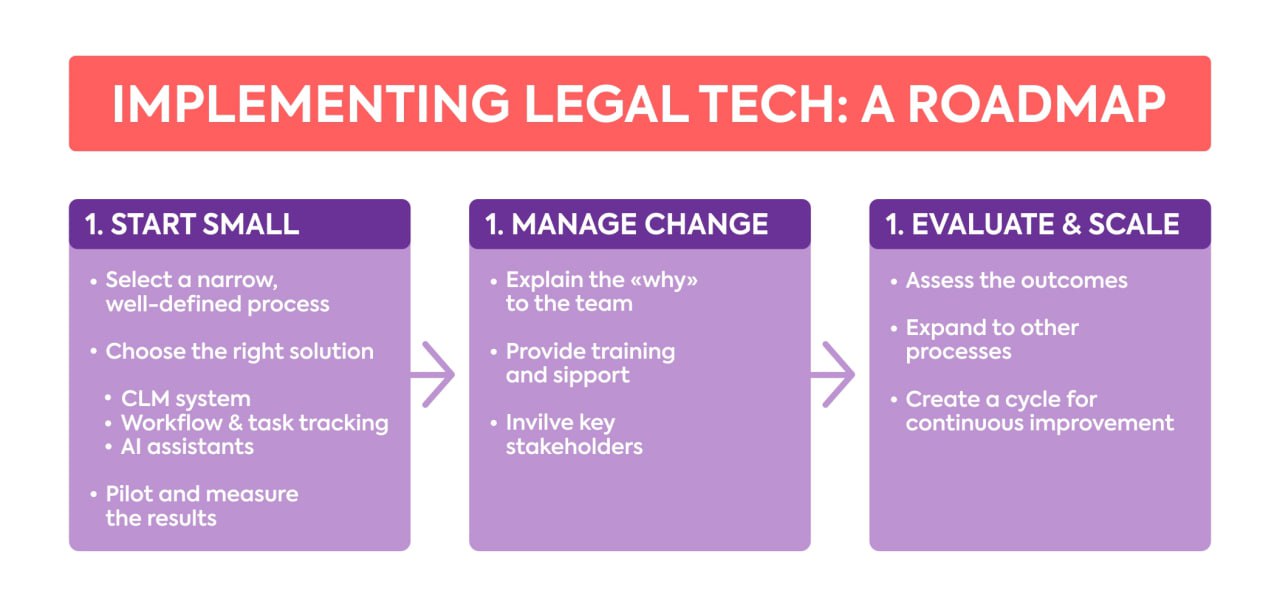By: Zhan Martirosyan. Legal Manager and LegalTech Specialist.
In this article, Zhan Martirosyan shares his experience and key principles for a successful transformation of a legal department from the perspective of a Legal Manager. The article covers the stages of LegalTech implementation, change management within the team, and methods for evaluating the effectiveness of new technologies. Special attention is given to the importance of cross-functional involvement and fostering a culture of continuous improvement.
In an era of rapid digitalization, legal departments can no longer remain on the sidelines. According to the Wolters Kluwer 2024 report, 76% of in-house counsel and 68% of law firm lawyers use GenAI at least once a week — with more than a third using it daily. 60% of lawyers believe that the efficiency of AI will reduce the importance of billable hours, and more than half of organizations plan to increase investment in LegalTech over the next three years. However, readiness for these changes remains limited: only 41% of corporate legal departments and 29% of law firms consider themselves fully prepared for new demands, including the growing need for ESG expertise.

The legal function faces significant challenges: constant overload, manual processes, lack of transparency, and pressure from the business regarding deadlines and outcomes. In this reality, the key role belongs to the Legal Manager — someone who can bridge the worlds of law, technology, and business goals.
How exactly do you lead a transformation? Below is a step-by-step practical guide.
Block 1: Preparing for Transformation — Strategy, Team, Goals
Digital transformation of a legal department is not about implementing a single system. It is a strategic shift in the way work is done. The preparation stage is critical to lay a strong foundation: understand where you are starting from, where you’re going, and who will help you get there.
1. Assess Your Starting Point
Goal: Identify real bottlenecks and build a current-state map.
What to do:
Inventory of processes: Describe the tasks the legal department performs daily: • Contract flow (standard and non-standard agreements) • Business requests (consultations, reviews, approvals) • Trials, compliance, reporting
Assess technological maturity: • Are electronic document management systems (EDMS) used? • Is there a CLM (Contract Lifecycle Management) system or e-signature? • How confidently do employees use these tools?
Collect feedback: • Conduct short interviews with legal staff and key internal clients (sales, finance, HR). • Ask: What tasks consume the most time? Which processes are unclear or slow down the business?
Outcome: You create a “problem and opportunity map” that will serve as the basis for your transformation strategy.
2. Define Transformation Goals
Goal: Set a clear direction and measurable benchmarks.
Examples of SMART goals: • Reduce the approval time for a standard contract from 10 to 3 business days • Automate 70% of internal legal requests via a portal or chatbot • Implement CLM by the end of the quarter and onboard 100% of the legal team
Additionally, define KPIs: • Time-to-Contract — time from request to signature • SLA for legal requests from other departments • ROI on LegalTech — time or cost savings achieved • NPS/CSAT — satisfaction level of internal clients
Important: Goals must be aligned with leadership and integrated into the overall business strategy.
3. Build a Project Team
One of the most common reasons for failure is lack of ownership. You need a dedicated team that shares the initiative and is able to implement changes in practice.
Team Composition
Lawyers — not just participants, but active agents of change. It is recommended to involve specialists from different areas: contract management, trial, and compliance.
IT representative — essential for system integration, configuration, and ensuring security.
LegalOps or Project Manager — responsible for coordination, timeline, and task backlog. If unavailable, the Legal Manager can temporarily assume this role.
C-Level or Head of Legal — needed to provide support, remove roadblocks, and signal the priority of the transformation.
At this stage, the Legal Manager becomes the key link between legal expertise, business objectives, and technical implementation. Their task is to facilitate dialogue, align interests, and keep the project on course.
Block 2: Implementing LegalTech & Change Management
Even with a clear strategy and goals, LegalTech implementation often encounters resistance, chaotic execution, and disappointment. To avoid this, it’s important to act systematically and remember that technology is just a tool — the real success factor is people.
Introducing LegalTech into legal practice is a crucial step toward improving efficiency and reducing manual workload. However, a structured approach and attention to the human factor are key to a successful transition.
1. Choose the Right Tools and Start Small
Avoid trying to digitize everything at once. Instead, focus on a narrow, high-impact area. For example, automating NDAsor setting up e-approvals for counterparty due diligence is a great starting point.
Popular LegalTech solutions include:
CLM systems (Contract Lifecycle Management) — e.g., Ironclad, Pravo.Tech, Contractbook
Workflow and task-tracking platforms — e.g., Asana, Monday, Jira, as well as LegalOps-specific tools
AI assistants — for case law analysis, legal research, and document draft generation
The key is to pilot a chosen tool with a specific success metric — for instance, reducing the number of email threads during contract approvals.
2. Manage Change: The Team Comes First
One of the most common reasons for failure is resistance from lawyers — driven by fear of losing relevance or reluctance to learn new systems. To overcome this:
Communicate the “why” — technology frees time for complex tasks, not replaces professionals
Train staff in accessible ways — through workshops, video tutorials, and micro-sessions
Engage internal opinion leaders in testing and rollout — this eases anxiety and builds trust
It’s crucial to understand that digital transformation in legal is not just a tool switch — it’s a shift in work processes and mindset. And the most important resource is still people — their motivation, adaptability, and willingness to learn. Without the team’s buy-in, even the most advanced LegalTech solutions will remain unused.
Change management must go hand in hand with technical implementation, creating space for dialogue, learning, and continuous improvement.
3. Evaluate Results and Scale
After the pilot, carefully measure effectiveness: Is the work faster and easier? Collect feedback from both internal and external users. If the results are positive, begin scaling the solution to other processes and teams.
For sustainable growth, create a continuous improvement loop:
- Run monthly retrospectives
- Set up a suggestion channel (e.g., Slack, Teams)
- Maintain transparent communication about wins and setbacks

Legal Transformation Is a Journey — Not a One-Time Implementation
Legal transformation doesn’t end with the rollout of a single system. It’s an ongoing journey — from a routine, isolated function to a strategic partner that helps the business make faster decisions and reduce risks.
The initiative starts with the Legal Manager — someone who sees the bigger picture and speaks the language of lawyers, business, and IT alike.
Start small. Focus on priority tasks. Stay persistent and adaptable.
And remember: even the longest journey begins with a single, deliberate step.
Sources:
Suarez, Christopher A., Disruptive Legal Technology, COVID-19, and Resilience in the Profession, South Carolina Law Review https://sclawreview.org/article/disruptive-legal-technology-covid-19-and-resilience-in-the-profession
Thomson Reuters, A 3-Step Plan to Building Your Legal Technology Roadmap https://legal.thomsonreuters.com/en/insights/articles/3-step-plan-to-build-your-legal-technology-roadmap
Wolters Kluwer, Future Ready Lawyer 2024 Report: Legal professionals confident in managing AI-driven changes to business of law, October 24, 2024 https://www.wolterskluwer.com/en/news/future-ready-lawyer-2024-report
Disclaimer: The content in this article is for informational purposes only and does not constitute legal, financial, or professional advice. The views and strategies presented are based on the author’s personal experiences and research. For advice tailored to your specific circumstances, it is recommended to consult with a qualified legal, technology, or business professional.

















